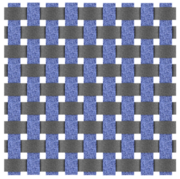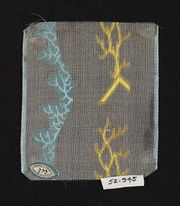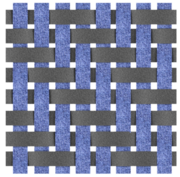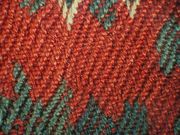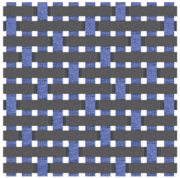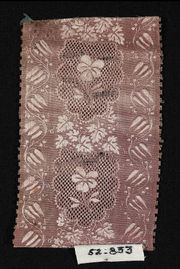Weaving
Jump to navigation
Jump to search
Description
A Textile production process of interlacing two threads or yarns at right angles. The longitudinal threads are called Warp and the lateral threads are called Weft. The patterns for connecting the warp and weft threads are called the weave.
Basic weave patterns are:
| Weave | Description | Diagram | Example |
|---|---|---|---|
| Plain (tabby) | The plain weave is the most basic weave, consisting of a 1 x 1 pattern produced by each weft strand going over and then under each alternating warp strand. Both the filling and warp threads are equal in thickness. This weave is very stable when being handled because of the frequent intersections of weft and warp making it dense and less likely to fray at the ends. Plain weave fabrics can be tightly or loosely woven. It is commonly used for linens and other simple cloth formats. Examples of plain weave fabrics are: Calico, Cambric, Canvas, Cheesecloth, Chiffon, Chintz, Crepe, Georgette, Gingham, Homespun, Linen, Muslin, Percale, Organdy, Seersucker, Tabby and Taffeta. Some variations of plain weave fabrics use different size filling and warp threads. Examples of these are Broadcloth, Grosgrain, Poplin, Faille, and Bengaline. Basketweave is a variation in which either the weft or warp or both consists of two of more threads in bundles. | ||
| Twill | A basic weave pattern that produces parallel, diagonal ribs on the front and a smooth face on the back. Twill weaves are made by two or more weft strands alternating over and under one or more warp strands. This produces a strong durable fabric with less tendency to wrinkle or show soil than plain weaves. Twills can be divided into even-sided, warp-faced, and weft-faced. Even-sided twills have the same amount of warp and weft threads visible on both sides of the fabric. Warp-faced twills have more warp threads visible on the face side, and weft-faced twills have more weft threads visible on the face side. The pattern can be either left-handed (upper left to lower right) or right-handed (lower left to upper right). Examples of commonly twill weave fabrics are: Gabardine, Serge, Drill, Denim, Surah, wool Broadcloth, Sharkskin cloth, and some Tweeds. Herringbone is a common variation in which the twill direction is reversed at regular intervals. | ||
| Satin | A basic weave pattern that produces a shiny luster on the front and a dull face on the back of the fabric. Satin weaves are made by each weft strand floating over 3-12 warp strands then under a single strand, while at the same time the warp threads also have the long to short pattern. The floating threads highly reflect light, thus producing the characteristic satin sheen. Additionally, this low frequency of weft/warp interruptions makes a flexible fabric that drapes well, but also snags easily. Silk, Polyester, and Nylon fibers are commonly used with this construction to create an elegant feel in high end finished garments or cloth. This weave is commonly used for lingerie, neckties, blouses and evening gowns. Examples of satin weave fabrics are Satin, Venetian cloth, and messaline. |
Synonyms and Related Terms
weave; ligamento (Esp.)
Resources and Citations
- Dexmat: Fabric Weave Patterns for Textiles and Composites Accessed March 2025
- Heddels: Seven Weave patterns to know Accessed March 2025
- Weaving Library at http://www.weavinglibrary.org
- Hermann Kuhn, Conservation and Restoration of Works of Art and Antiquities, Butterworths, London, 1986
- Hoechst Celanese Corporation, Dictionary of Fiber & Textile Technology (older version called Man-made Fiber and Textile Dictionary, 1965), Hoechst Celanese Corporation, Charlotte NC, 1990
- Fairchild's Dictionary of Textiles, Phyllis G.Tortora, Robert S. Merkel (eds.), Fairchild Publications, New York City, 7th edition, 1996
- Britannica: Basic Weaves Access March 2025
- Textile Learner: Twill Weave: Features, Classification, Derivatives and Uses Accessed March 2025
